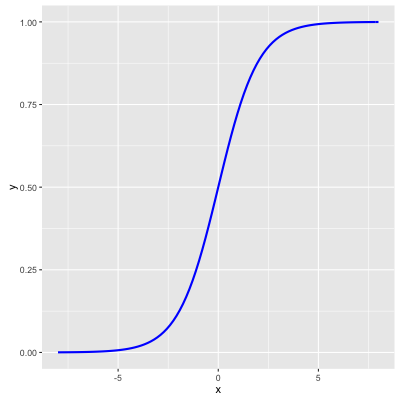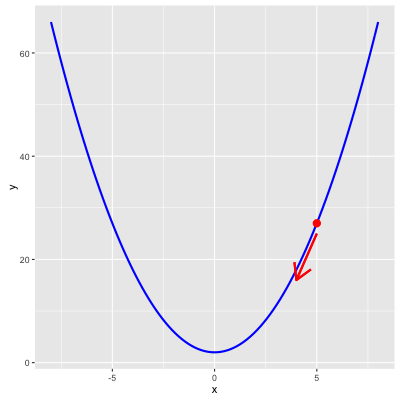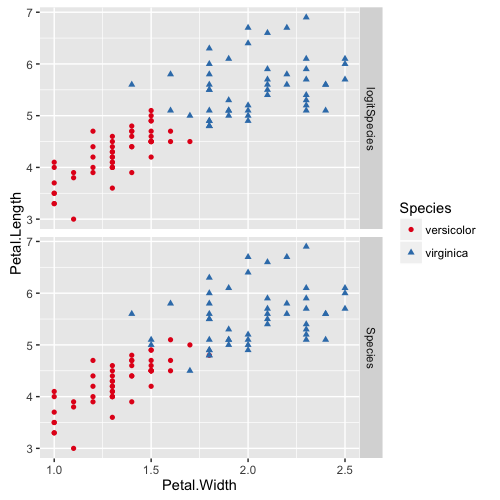本文介绍logistic回归的相关知识,以及用R语言来实现逻辑回归,解决分类的问题
二分类logistic回归介绍
logistic回归是用来解决分类问题的统计或机器学习模型,这里我们只介绍最简单的 二分类logistic回归 。这个模型经常用于识别垃圾邮件、判断病人是否有疾病、预测客户是否买房等等。
1. logistic函数和logit变换
现在普及两个基础函数:
- logistic函数。$f(x)=\frac{1}{1+e^{-x}}$
- logit变换。$logit P=ln(\frac{P}{1-P})$
有趣的是,logit变换是logistic函数的反函数 ,$f(x)=\frac{1}{1+e^{-x}}$ , $g(x)=ln(\frac{P}{1-P})$, $g(f(x))=ln(\frac{\frac{1}{1+e^{-x}}}{1-\frac{1}{1+e^{-x}}})=x$
1 | library(ggplot2) |
logistic函数图形如下,它是 Sigmoid函数 最重要的代表:

2. 二分类logistic回归详解
比如要解决二分类问题,我们最先想到的是建立个线性回归方程 $y = \mathbf {w}^{T}\mathbf {x} + b$ 。但是这个回归方程 $y$ 的取值范围不受约束,而 $y$在分类问题中应该只有 1 和 0 两个取值(1代表正例,0代表反例),自然想到将它代入logistic函数,得 $y = \frac{1}{1+e^{-(\mathbf {w}^{T}\mathbf {x}+b)}}$ , $y$ 取值在0~1之间。
上式推导:
这样的话,我们的 logistic回归方程 为
odds和log odds
如 $y$ 表示样本取1的概率(正例),$1-y$ 表示样本取0的概率(反例)。则 $\frac{y}{1-y}$ 代表样本取正例的相对可能性,记为 odds ,log odds 是 $ln\frac{y}{1-y}$ ,称为 对数几率
极大似然估计
有了回归方程后就可以用 极大似然估计进行参数估计
若将 回归方程 中的 $y$ 当作后验概率,则回归方程可写为
$y$ 和 $1-y$ 分别写为
假设有n个独立的训练样本,$(x_{1},y_{1}),(x_{2},y_{2})…(x_{n},y_{n})$ , $y\in (0,1)$
设 $p_{i}=P(y_{i}=1\mid x_{i})$ 是 $y_{i}=1$ 的概率,那么 $y_{i}=0$ 的概率就是 $1-p_{i}$
任意一个观测值 $(x_{i},y_{i})$ 出现的概率是
容易构造 似然函数
取对数即得到 对数似然函数
接下来的问题就是最大化似然函数来求解参数。这里就要用到一些经典的 数值优化算法
3. 参数求解方法
梯度下降法(gradient descent)
1 | geom_segment(aes(5,25,xend=4,yend=16),arrow=arrow(),size=1,color="red") |

简单介绍一下梯度下降法。梯度下降法是一种寻找局部最优的算法。以上图的抛物线 $y=x^{2}+2$ 为例,假设我们选定初始点(5,27),对于这个点对 $x$ 求偏导数为 $2x$ ,即4。沿着+4的方向,y值会变大,称为 梯度上升;沿着-4的方向,y值变小,称为 梯度下降 。
梯度下降法有两个关键:
- 初始点的选择
- 下降的速度
未完待续…
牛顿法(newton method)
牛顿法是二阶收敛,相比一阶收敛的梯度下降法能更快的找到最优解
拟牛顿法(newton-raphson method)
5. R语言实例
1 | # logistic regression |
x数据集如下,其中 models 为 Species 的是花瓣真实分类, logitSpecies 代表 logistic回归 预测的分类
1 | > head(x) |
下图比较预测值和真实值的区别,可以看到预测的结果还是不错的~
1 | p = ggplot(data = x, |

1 | > table(iris_total$Species,iris_total$logitSpecies) |
一共100个样本,分类错误样本为6个,正确率94%

